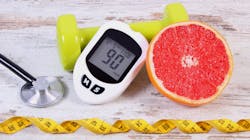An interprofessional approach to managing diabetic patients
Dental practitioners are naturally concerned with what is going on with their patients’ oral health. In a similar manner, medical practitioners are generally unfamiliar with the complexities of oral health. However, it is our belief that the sooner dental and medical practitioners begin to show a greater interest in overall health, the better. The human body is much more than the sum of its parts.
This series on dental solutions to medical problems has highlighted the need for collaboration and cooperation. This is true not only within dental settings, but between dental and medical practitioners on the local level. Indeed, we can all look forward to better public health if we work together to overcome the separated nature of health care that currently exists.
Today we look at diabetes—a preventable yet widespread disease in the United States—and how we can take action to combat it more effectively.
Diabetes in the dental office: Why awareness is important
Diabetes is a metabolic disease that has grown in our society to the level of an epidemic.1 It is characterized by hyperglycemia due to lack of insulin secretion, a state of insulin resistance, or both. It can cause damage, dysfunction, and failure of vital organs in the body.2 In the context of dentistry, there is a link between diabetes and certain oral diseases and pathologies.
How diabetes impacts dentistry
For those of us who are dental hygienists, we must make it our business to be aware of the root causes of any problems we see in the oral region. The more we understand what is going on medically, the more we can be of service to our patients. In the case of diabetes, treating oral complications effectively and establishing an early diagnosis of the disease can vastly improve patients’ chances of obtaining glycemic control.2
Here are some of the most common oral health issues associated with diabetes that are likely to be observed in dental offices:2
Periodontitis—Described as the “sixth complication” of diabetes, the link between diabetes and periodontitis is clear.3 Each disease exacerbates the other, and therefore it is advisable to investigate whether both are present.
Obstructive sleep apnea—There is a connection between obstructive sleep apnea and type 2 diabetes.4 They may be co-occurring.
Malocclusion—Because malocclusion can cause many health issues, including an increased risk of diabetes, it is essential to consider it as co-occurring.5
Oral manifestations—This covers many everyday oral health problems, such as dry mouth, tooth decay, gingivitis, oral fungi, and mouth ulcers.6 While these can exist without diabetes being present, it is worth probing further in case they are not occurring in isolation.
Salivary dysfunction—Dry mouth/xerostomia is more common in patients with diabetes. Check to see if diabetes could be contributing to dryness and inflammation.7
Taste disturbance—This is another potential sign of diabetes. It can lead to problems maintaining a healthy diet and glycemic control.
Dental caries—Reduction of the pH in the saliva of diabetic patients will typically increase cariogenic bacteria in the mouth, which in turn contributes to the blocking of protective microflora.
Delayed wound healing and persistent infections—Patients with diabetes take longer to heal, making persistent infections and delayed healing telltale signs to note.
Burning mouth syndrome—This painful condition is prevalent with diabetes8 and vitamin B deficiency.9
Oral lesions—Mouth ulcers are also especially frequent with diabetes.10
Seeing the patient: Prevention and intervention
Aside from comorbidity of diabetes with oral issues and the clues it gives us, it is pertinent to investigate a patient’s history and other symptoms.4 An important first question would be “Have you ever had a diabetes diagnosis?” With 9.4% of Americans already diagnosed with diabetes and 84 million having prediabetes, it seems obvious, yet we do sometimes forget.11
Follow this by investigating the oral symptoms12 and the more “classic” diabetes symptoms, such as polyuria (frequent urination), polydipsia (excessive sense of thirst), polyphagia (excessive sense of hunger or inability to remain satiated after a meal), recent vision changes, or rapid weight loss.4
“Seeing” patients means seeing them in their entirety. You may observe oral pathogens and diseases, but what if a question you ask or an observation you make leads to better long-term health for your patient? Or what if it makes the difference between the success and failure of a dental implant because the patient has had a proper diagnosis?
Patients may not be accustomed to answering detailed health questions when entering the dental office, but if they feel that someone on the health-care spectrum cares about them enough to ask, they will feel more secure.
The COVID-19 pandemic
When talking about diabetes, we cannot avoid discussion around the COVID-19 pandemic. In light of this health threat, we need to continue to protect the vulnerable in our society. Metabolic disorders such as diabetes and thosethat cause systemic inflammation leave patients vulnerable to viral infection.
As we strive to emerge from the COVID-19 crisis, it is crucial to remain vigilant and ultraobservant so we can help patients with weakened systems protect themselves against this—or the next—virus.
Time to act
It is easy to focus purely on one’s area of expertise, but the human body functions as a whole. Although it is extremely challenging, we need to strive to educate ourselves on the tools we need to improve overall patient health.
Historically, and even now, it is challenging to open communication channels between medical and dental practices. But it is time for a change.
An interprofessional approach: The who, what, and when
As a dental professional, you may well be out of your comfort zone with investigating diabetes, and protocols for doing so may not be part of your job description. If this is the case, we are glad you are reading this article. We realize that you likely have further questions, which we have attempted to answer here:
Who will be my ally? If your practice does not have protocols for expanding your scope of evaluation, ask why. Talk with your peers and try to evolve as a team within your practice. Reach out to local medical practices and clinics that educate patients and the community on diabetes. Tell them what you are seeing in your daily work and start collaborating. You may come up against resistance or an attitude of “I’m too busy.” Don’t be deterred. Change must start somewhere.
What can we do collectively? Being more aware of diabetes and related comorbidity is a fantastic start. By communicating and collaborating with our local health-care networks, we can achieve a great deal in terms of creating protocols for shared patients. We can put in place an early warning system for those at risk and collectively manage those with a diagnosis.
When is a good time to start this approach? Now! Never has this issue been more urgent. During a global pandemic, we have the perfect opportunity to speak more openly about health, how we approach it, and how we can absolutely do better.
Diabetes is one of the biggest threats to public health, and better care is within reach. Remember, change begins with us, and it grows as a shared health-care community.
References
1. Diabetes Statistics. Diabetes Research Institute Foundation. Accessed June 8, 2020. https://www.diabetesresearch.org/diabetes-statistics
2. Kataria R, Rathee I, Khader AA, et al. Diabetes and dental health—a review. Saudi J Med. April 16, 2019. doi:10.21276/sjm.2019.4.4.4
3. Preshaw PM, Bissett SM. Periodontitis and diabetes. Br Dent J. 2019;227(7):577-584. doi:10.1038/s41415-019-0794-5
4. Rasche K, Keller T, Tautz B, et al. Obstructive sleep apnea and type 2 diabetes. Eur J Med Res. 2010;15 Suppl 2(Suppl 2):152-156. doi:10.1186/2047-783x-15-s2-152
5. Worrall J. Hygienists: First responders for the airway. Hygienetown. Accessed June 17, 2020. https://www.hygienetown.com/magazine/article/7693/hygienists-first-responders-for-the-airway
6. Diabetes and oral health. Victoria State Government BetterHealth Channel. Accessed June 15, 2020. https://www.betterhealth.vic.gov.au/health/ConditionsAndTreatments/diabetes-and-oral-health
7. Duggal N. What you should know about dry mouth and diabetes. Healthline. August 9, 2016. Accessed June 15, 2020. https://www.healthline.com/health/diabetes/dry-mouth-diabetes
8. Senthil B, Shanmugam S, Elangovan S, et al. Comparative study: Oral mucosal lesions, signs and symptoms in diabetes mellitus patients with end stage renal disease with analogous findings in diabetes mellitus patients with non-end stage renal disease. Indian J Dent Res. 2017;28(4)406-412.
9. Kim Y, Yoo T, Han P, Liu Y, Inman JC. A pragmatic evidence-based clinical management algorithm for burning mouth syndrome. J Clin Exp Dent. 2018;(4)10:e321-e326.
10. Scully C, Shotts R. ABC of oral health. Mouth ulcers and other causes of orofacial soreness and pain. BMJ. 2000;321(7254):162-165. doi:10.1136/bmj.321.7254.162
11. New CDC report: More than 100 million Americans have diabetes or prediabetes. Centers for Disease Control and Prevention. July 18, 2017. Accessed June 15, 2020. https://www.cdc.gov/media/releases/2017/p0718-diabetes-report.html
12. Morris SW. What does bad breath have to do with diabetes? Healthline. August 20, 2018. Accessed June 15, 2020. https://www.healthline.com/health/diabetes/bad-breath
MICHELLE STRANGE, MSDH, RDH, is the cofounder and cohost of A Tale of Two Hygienists podcast. Her passion for dentistry and its connection to overall health extends to her community and global efforts, most notably in her work as a weekly dental hygienist volunteer and annual dental mission trip leader.
JULIA WORRALL, RN, CCRN, is the executive director of Functional Airway and Craniofacial Education (FACE). In uniting proven experts from all fields of health care, FACE helps clinicians create an integrated network of providers and ultimately optimize patient care. Worrall is a faculty member of the Indian Society for Sleep Research. She lectures internationally and is an expert in applying sleep and craniofacial assessments in various health-care environments.
About the Author
Michelle Strange, RDH
Michelle Strange, RDH, is a dedicated dental hygienist and educator passionate about infection control and patient safety. With over 20 years of experience in clinical practice, Michelle is committed to sharing evidence-based solutions to improve dental care outcomes.

Julia Worrall, RN, CCRN
Julia Worrall, RN, CCRN, also known as the Sleep RN, is a highly sought-after expert in sleep and airway health, connecting what was once thought to be disconnected. She is asked to speak at conferences and high-level meetings and featured on podcasts around the world. As a passionate airway advocate and mentor, Ms. Worrall continues to march forward on her mission to drive innovative research and prevent disease through area-specific education.
Updated November 20, 2020

